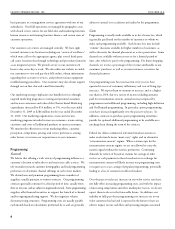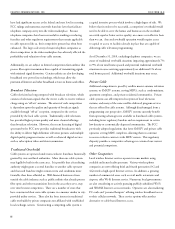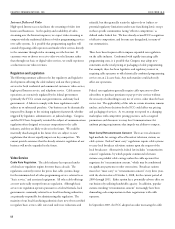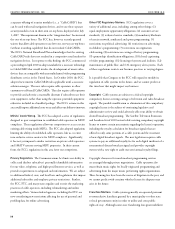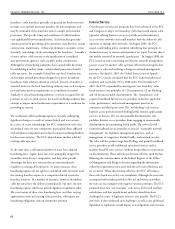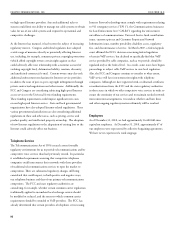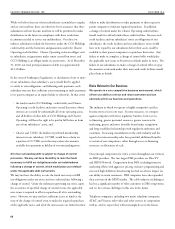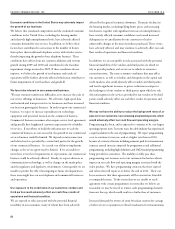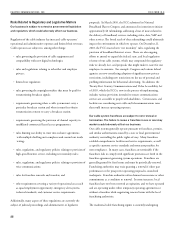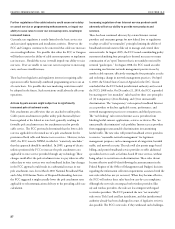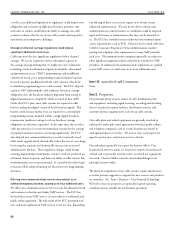Charter 2010 Annual Report Download - page 31
Download and view the complete annual report
Please find page 31 of the 2010 Charter annual report below. You can navigate through the pages in the report by either clicking on the pages listed below, or by using the keyword search tool below to find specific information within the annual report.
governing our long-term indebtedness. In addition, the secured
lenders under the Charter Operating credit facilities, the holders
of the Charter Operating senior second-lien notes, and the secured
lenders under the CCO Holdings credit facility could foreclose on
their collateral, which includes equity interests in our subsidiaries,
and exercise other rights of secured creditors. Any default under
those credit facilities or the indentures governing our debt could
adversely affect our growth, our financial condition, our results of
operations and our ability to make payments on our notes and credit
facilities, and could force us to seek the protection of the bankruptcy laws.
We depend on generating (and having available to the applicable
obligor) sufcient cash ow to fund our debt obligations, capital
expenditures, and ongoing operations.
We are dependent on our cash on hand and free cash flow to fund
our debt obligations, capital expenditures and ongoing operations.
Our ability to service our debt and to fund our planned capital
expenditures and ongoing operations will depend on our ability
to continue to generate cash flow and our access (by dividend or
otherwise) to additional liquidity sources at the applicable obligor.
Our ability to continue to generate cash flow is dependent on many
factors, including:
our ability to sustain and grow revenues and free cash flow
by offering video, high-speed Internet, telephone and other
services to residential and commercial customers, to adequately
meet the customer experience demands in our markets and to
maintain and grow our customer base, particularly in the face
of increasingly aggressive competition, the need for innovation
and the related capital expenditures and the difficult economic
conditions in the United States;
the impact of competition from other market participants,
including but not limited to incumbent telephone companies,
direct broadcast satellite operators, wireless broadband providers
and DSL providers and competition from video provided over
the Internet;
general business conditions, economic uncertainty or downturn,
high unemployment levels and the level of activity in the
housing sector;
our ability to obtain programming at reasonable prices or to
•
•
•
•
raise prices to offset, in whole or in part, the effects of higher
programming costs (including retransmission consents); and
the effects of governmental regulation on our business.
Some of these factors are beyond our control. If we are unable to
generate sufficient cash flow or we are unable to access additional
liquidity sources, we may not be able to service and repay our debt,
operate our business, respond to competitive challenges, or fund our
other liquidity and capital needs.
Restrictions in our subsidiaries' debt instruments and under
applicable law limit their ability to provide funds to us and our
subsidiaries that are debt issuers.
Our primary assets are our equity interests in our subsidiaries. Our
operating subsidiaries are separate and distinct legal entities and
are not obligated to make funds available to us for payments on
our notes or other obligations in the form of loans, distributions,
or otherwise. Charter Operating’s and CCO Holdings’ ability to
make distributions to us or the applicable debt issuers to service debt
obligations is subject to their compliance with the terms of their
credit facilities and indentures, and restrictions under applicable
law. See “Part II. Item 7. Management’s Discussion and Analysis
of Financial Condition and Results of Operations — Liquidity
and Capital Resources — Limitations on Distributions” and
“— Summary of Restrictive Covenants of Our Notes – Restrictions
on Distributions.” Under the Delaware Limited Liability Company
Act (the “Act”), our subsidiaries may only make distributions if the
relevant entity has “surplus” as defined in the Act. Under fraudulent
transfer laws, our subsidiaries may not pay dividends if the relevant
entity is insolvent or is rendered insolvent thereby. e measures
of insolvency for purposes of these fraudulent transfer laws vary
depending upon the law applied in any proceeding to determine
whether a fraudulent transfer has occurred. Generally, however, an
entity would be considered insolvent if:
the sum of its debts, including contingent liabilities, was greater
than the fair saleable value of all its assets;
the present fair saleable value of its assets was less than the
amount that would be required to pay its probable liability
on its existing debts, including contingent liabilities, as they
become absolute and mature; or
it could not pay its debts as they became due.
•
•
•
•


